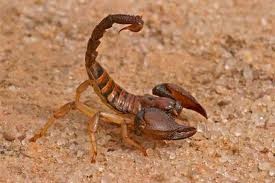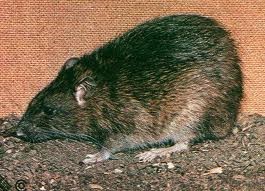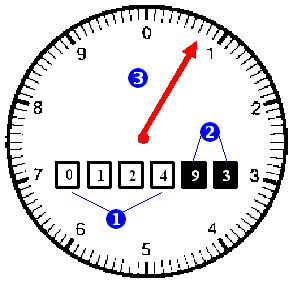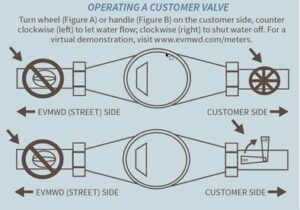Meter Box Maintenance
The District is responsible for maintaining all elements of water meter boxes located at customer properties. These responsibilities include repairing the meter, the customer valve on the customer side of the meter, the angle meter valve on the District side of the meter, removing dirt from boxes, and removing pests (small animals, snakes, and insect infestations (bees/wasps/hornets and hives, ant colonies, large spider nests, etc.).
***CUSTOMERS SHOULD USE EXTREME CAUTION WHEN REMOVING METER BOX LIDS DUE TO THE POTENTIAL OF THE BELOW HAZARDS!!!***
Pests & Insect Infestations




Meter boxes can be attractive locations for pest and insects to build homes since they are enclosed, dark and offer a cool environment.
Even though a majority of meter boxes don’t have any pest issues, the District strongly recommends that customers use caution when opening box lids. Customers should be prepared to move away from the box if there are signs of pests. Also, while many pests might not be immediately visible it is a good idea to wear a glove before putting your hand in the box, or at least probe the area with a long screwdriver or stick.
Caution is always the best practice!
Meter Box Location
Most meter boxes will be located at the front of the property in the grass or driveway close to the street, and may be covered by a green plastic composite or concrete lid. The meter box houses the following equipment, starting from the street side:
1. Angle Meter Stop: this is a valve that should only be operated by District staff.
2. Water Meter
3. Radio Reading Equipment: there is a wire that comes from the top of the register connected to a small box containing a radio transmitter and long life battery. Customers should not disturb this equipment.
4. Most meters will have a customer valve that has a handle and can be operated by customers and can be used to turn off water to the property. CAUTION: To prevent damage to on-site water using devices and other plumbing, this valve should be turned on and off very slowly.
District vs. Customer Responsibility
The District is responsible for maintaining the water service from the connection to the water main in the street to all of the contents of the meter box, including repairing and/or replacing the actual meter box and lid. The customer is responsible for all plumbing on the property from the meter box.
Construction or Planting Near Water Meter Boxes
Customers should not replace, cover, move or change the configuration and installation of the meter box in any way as it may impact on-site plumbing and access to the meter.
Also, meter boxes, and most other utilities, are located in what is referred to as the property’s public easement and requires that District staff have complete unfettered access to the meter box at any time for reading, locking off and restoring service, maintenance or emergency repairs to the meter.
This includes planting trees or bushes that can damage or block the meter box; or installing fencing or walls that encloses the meter box within the fence or wall line, or building a wall directly over a meter box. Customers will be asked to remove, at their expense, fencing and walls or pay for the relocation of the meter if feasible.
Who to Call
Customers that require maintenance of the meter box should call the District’s Customer Service department during normal business hours (Monday – Thursday, 7:30 am – 5:30 pm; Friday, 7:30 am – 4:30 pm) at 951-674-3146, Option 1, and provide specific details of the maintenance need.
If there is an emergency issue (water leak in the box, imminent threat from a pest or other problem) that arises outside of normal business hours, then contact the District at 951-674-3146 and select Option 7 for our After Hours Emergency Answering Service that will contact District staff to respond to the issue.
If there is a pest infestation, please do not call a pest control company. The District will contact a company to handle the problem.
Understanding your Meter
Meters are mechanical devices that record the volume of water passing from District water supply lines to the property being served. The register on the meter is similar to a car odometer. Just as a car’s odometer will not progress if the vehicle doesn’t move, the numbers on a water meter register will not move unless there is water flowing through the meter.
Currently, all District meters are fitted with radio transmission devices. Currently, meters in the District are read remotely via our Advanced Metering Infrastructure (AMI). The District began the conversion to AMI technology in 2017, and the project was completed in 2018. AMI allows the District to read all meters remotely from the District office eliminating the need to send a meter reader to your property, reducing CO2 emissions which directly reduces EVMWD’s carbon footprint. . With AMI, Data Collection Units (DCUs) are strategically placed throughout the serving area to ensure triple redundancy. These DCUs collect the meter readings on an hourly basis and transmit them electronically four times a day for billing purposes. AMI allows the District to provide customers access to view their hourly usage via Aquahawk, our customer online water usage analyzer tool.
How to Read Your Meter
The first step is finding where your meter is located. Normally, your meter will be located in a meter box close to the street either in the lawn area near the sidewalk or close to the driveway. Please use caution when removing the lid, because sometimes small animals, reptiles and other pests use the meter box as a home.
You will see your meter with a pipe coming in from the street side and a pipe leading to the property. On top of your meter will be a register that will look similar to one of the registers pictured below.
The elements of each meter register are essentially the same.
1. The first four digits from the left indicate the total number of ccf (hundred cubic feet, each unit is equal to 748 gallons) has passed through the meter over the life of the register. Imagine a decimal point after these numbers. This is the number that appears on your monthly water bill as the reading, since the District only bills for complete units.
2. Each number after the decimal represents a portion of one whole ccf. In the case of the first register, it shows the tenths, hundredths, thousandths, and ten thousandths places. The second register shows only the tenths and hundredths places.
3. Each register is equipped with a dial or sweep hand, commonly referred to as a “tattletale,” which shows if even a very small quantity of water is passing through the meter. If the sweep hand or the small circle with a point (some registers have a triangle) is moving, then water is passing through the meter.


Calculating Your Water Usage
Your meter can also be used to calculate usage over a period of time, or if you want to see how much water a particular device uses.
Example 1: John wants to determine how much water his property uses over a 10 day period.
First, the meter must be read. John writes down all of the numbers on his meter, and places a decimal point after the 4th number. Ten days later he reads the meter and writes down all of the numbers again.
Day 1 Reading: 0000000452.3256
Day 10 Reading: 000000463.9245
Subtract Day 1 from Day 10 reading to determine the total usage.
Total Usage: 000000000011.5989 ccf
John used over 11 ccf during the 10 day period. In order to determine how many gallons is represented by the numbers after the decimal, John needs to multiply .5989 by 748 (1 ccf = 748 gallons), which equals 447.98 gallons. So he knows that he used 11 ccf and about 448 gallons.
If John wants to determine how many gallons the total usage during the 10 days represents, then he needs to multiply 11.5989 by 748, which is equal to 8,675.98 gallons.
Example 2: Maria wants to know how much water she uses on an average daily basis.
In order to find an average, Maria should not alter her water consumption in any way and read the meter over at least 7 days since usage can change depending on whether it is a weekday or a weekend day (Keep in mind that average daily usage also changes depending on if landscaping is being watered during hot months, and other factors). Maria must also read her meter at the same time each day for consistency; and write down all of the numbers she sees on the meter, remembering to place a decimal after the 4th number.
Day 1 Reading, 7 am: 0012.5632
Day 2 Reading, 7 am: 0012.9862
Subtract Day 1 from Day 2 reading and write that number down.
Day 3 Reading, 7 am: 0013.8624
Subtract Day 2 from Day 3 reading and write that number down.
Day 4 Reading, 7 am: 0014.3712
Subtract Day 3 from Day 4 reading and write that number down.
Day 5 Reading, 7 am: 0014.9536
Subtract Day 4 from Day 5 reading and write that number down.
Day 6 Reading, 7 am: 0015.9841
Subtract Day 5 from Day 6 reading and write that number down.
Day 7 Reading, 7 am: 0016.6214
Subtract Day 6 from Day 7 reading and write that number down.
Maria recorded the following usage for each of the days:
(0.4230 ccf + 0.8762 ccf + 0.5088 ccf + 0.5824 ccf + 1.0305 ccf + 0.6373 ccf) = 4.0582 ccf total
Maria knows that she used over 4 ccf over the course of six full days. In order to find out how much water she used on average each day Maria divides 4.0582 ccf by 6; and determines that, on average, she uses .6764 ccf, or about (.6764 ccf x 748 gallons) 506 gallons per day.
Example 3: Henry wants to know how much water he is using on the inside of his home compared to his outdoor landscape watering.
Henry can use either of the methods described in Example 1 & 2. Henry will take readings for several days while the outdoor landscaping system is OFF and determine what the average or total usage is. This will be his indoor usage only.
Then Henry will turn ON his outdoor landscaping system and take additional readings to determine what the average or total usage is for BOTH indoor and outdoor. For Henry to determine what his outdoor usage is, he will subtract the indoor usage he obtained with the first readings from the total of indoor and outdoor usage he obtained on the second set of readings.
If Henry finds that he is using too much water outdoors, then he can adjust the outdoor landscaping system settings and take additional readings to determine how much water he will save with the adjustment.
How To Turn Off Your Meter
If emergencies strike, are you prepared to turn off your meter? Your main valve is located where your water supply enters the house, usually in a meter box near the curb in front of your house. Follow these instructions to turn it off:
- Lift the cover with a large screwdriver.
- Follow the instructions in the diagram to turn off the water. Turning clockwise will turn the water off.
- If your meter is equipped with a handle, turn the handle a quarter turn to the right (clockwise), so that it is perpendicular to the box. This will turn the water off.
- Turning it counterclockwise while in the on position could destroy the valve. Do not attempt to turn the angle stop valve on the
- District (street side) of the meter.
- Drain all water from the system, including your hot water heater, if you must evacuate of if the weather is very cold.

